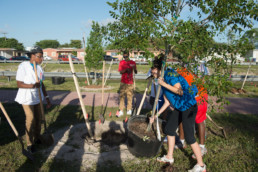The SHADE project: Shaping Healthy Active Deep-rooted Environments
Year Complete: 2016
Grant Amount: $50,000
Local Government: Miami-Dade County Office of Sustainability
Local Foundation: Health Foundation of South Florida
Project Purpose
To incorporate sustainability into the health efforts of two South Florida communities by empowering them to cultivate shaded open spaces that promote physical activity.
Key Lessons Learned
Lessons learned about tools and tactics through the project that other sustainability directors could use to advance their work.
- Selecting a planting location on public property required maneuvering through multiple layers of government bureaucracy; this step took the most time.
- Dealing with two different government administrations meant employing different approaches; know your government bureaucracy – some are bigger than others and may have more layers to go through. Some may be smaller and therefore it may be harder for them to take on more work.
- Finding a maintenance partner (for tree watering, trimming, etc.) is critical, but not easy; maintenance is always an issue and cannot be disregarded.
- Be aware that local governments may be resistant to accepting responsibility for maintaining the trees, even though the project paid for procuring and planting them.
- Early media attention is hard to sustain.
- This project helped bring visibility to other projects.
- Linking tree shade to increasing physical activity really seemed to open people’s eyes to the benefits of trees.
- Partnering with local non-profits and getting early buy-in from respected community members helped the project gain momentum relatively quickly. The more partners, the better.
- Municipalities with active tree-planting or beautification programs can be easier to work with.
- Allow for more time than you would think for community outreach; it is very difficult to get residents to meetings during the week.
- Engage the community at every step; this helped to ensure the survival rate of the trees.
- Informational door hangers placed on homes near the planting locations helped provide notice to neighbors and ensure no one would be surprised. It also helped address complaints in advance. There were no complaints and some neighbors were encouraged to come out to the plantings.
- Although it was anticipated by SHADE Project partners, there was no pushback about the trees once they were planted – in fact the only feedback received was extremely positive.
- The i-Tree assessment tool was easy to use and helpful in quantifying the sustainability benefits of the new trees.
Lessons for developing a collaborative process between a local government sustainability director and local place-based foundation(s).
- Initiate the relationships with your local foundations even though you might not have a project to collaborate on yet.
- Allow time for the relationship to grow and evolve.
- All good relationships take “work,” including professional relationships. Make sure you maintain the connection by occasionally reaching out to your foundation contacts by asking for their advice or perspective on an issue that could be applicable to them, sending them articles of interest, or networking with them in other ways. This makes it easier for them to think of you when a project of mutual interest arises.
- Once you are familiar with each other, you’ll continue to identify opportunities to work together.
Additional Information and Resources
The project was successful in strategically planting 132 trees in Miami Gardens and 100 trees in Little Havana to incentivize residents to engage in physical recreation and/or exercise. Its success led to a second phase devoted to improving access to transit stops, and increasing the number of accommodations in the transit areas. Read more about each phase of this project here.

